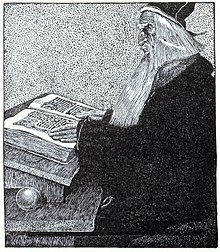| Merlin | |
|---|---|
| Matter of Britain character | |
 The Enchanter Merlin, Howard Pyle's illustration for The Story of King Arthur and His Knights (1903) | |
| First appearance | Prophetiae Merlini |
| Created by | Geoffrey of Monmouth |
| Based on | Myrddin Wyllt and Ambrosius Aurelianus |
| In-universe information | |
| Species | Cambion |
| Occupation | Prophet, magician, bard, advisor, warrior, others (depending on the source)[note 1] |
| Spouse | Gwendolen |
| Significant other | Lady of the Lake, Morgan le Fay, Sebile (romance tradition) |
| Relatives | Ganieda |
| Home | "Esplumoir Merlin", British woods |
Merlin (Welsh: Myrddin, Cornish: Merdhyn, Breton: Merzhin)[note 2] is a mythical figure prominently featured in the legend of King Arthur and best known as a magician, with several other main roles.[note 3] The familiar depiction of Merlin, based on an amalgamation of historical and legendary figures, was introduced by the 12th-century British pseudo-historical author Geoffrey of Monmouth and then built on by the French poet Robert de Boron and prose successors in the 13th century.
Geoffrey seems to have combined earlier Welsh tales of Myrddin and Ambrosius, two legendary Briton prophets with no connection to Arthur, to form the composite figure that he called Merlinus Ambrosius. His rendering of the character became immediately popular, especially in Wales.[6] Later chronicle and romance writers in France and elsewhere expanded the account to produce a more full, multifaceted character, creating one of the most important figures in the imagination and literature of the Middle Ages.
Merlin's traditional biography casts him as an often-mad cambion, born of a mortal woman and an incubus, from whom he inherits his supernatural powers and abilities.[7] His most notable abilities commonly include prophecy and shapeshifting. Merlin matures to an ascendant sagehood and engineers the birth of Arthur through magic and intrigue.[8] Later stories have Merlin as an advisor and mentor to the young king until he disappears from the tale, leaving behind a series of prophecies foretelling events to come. A popular version from the French prose cycles tells of Merlin being bewitched and forever sealed up or killed by his student, the Lady of the Lake after he fell in love with her. Other texts variously describe his retirement, at times supernatural, or death.
- ^ "Frequently Asked Questions about the Arthurian Legends | Robbins Library Digital Projects". d.lib.rochester.edu. Archived from the original on 28 November 2020. Retrieved 27 June 2019.
- ^ Goodrich, Peter H. (15 June 2004). Merlin: A Casebook. Routledge. ISBN 9781135583408. Archived from the original on 15 March 2023. Retrieved 15 March 2023 – via Google Books.
- ^ "The Dublin University Magazine: A Literary and Political Journal". W. Curry, jun., and Company. 15 March 1864. Archived from the original on 15 March 2023. Retrieved 15 March 2023 – via Google Books.
- ^ Whetter, Kevin Sean (2017). The Manuscript and Meaning of Malory's Morte Darthur: Rubrication, Commemoration, Memorialization. Boydell & Brewer. ISBN 978-1-84384-453-2. Archived from the original on 2024-04-04. Retrieved 2024-04-04.
- ^ Goodrich, Peter H. (June 2004). Merlin: A Casebook. Routledge. ISBN 9781135583408.
- ^ Lloyd-Morgan, Ceridwen. "Narratives and Non-Narrtives: Aspects of Welsh Arthurian Tradition." Arthurian Literature. 21. (2004): 115–136.
- ^ Katharine Mary Briggs (1976). An Encyclopedia of Fairies, Hobgoblins, Brownies, Boogies, and Other Supernatural Creatures, p.440. New York: Pantheon Books. ISBN 0-394-73467-X
- ^ Geoffrey of Monmouth (1977). Lewis Thorpe (ed.). The History of the Kings of Britain. Penguin Classics. Penguin Books. ISBN 978-0-14-044170-3.
Cite error: There are <ref group=note> tags on this page, but the references will not show without a {{reflist|group=note}} template (see the help page).